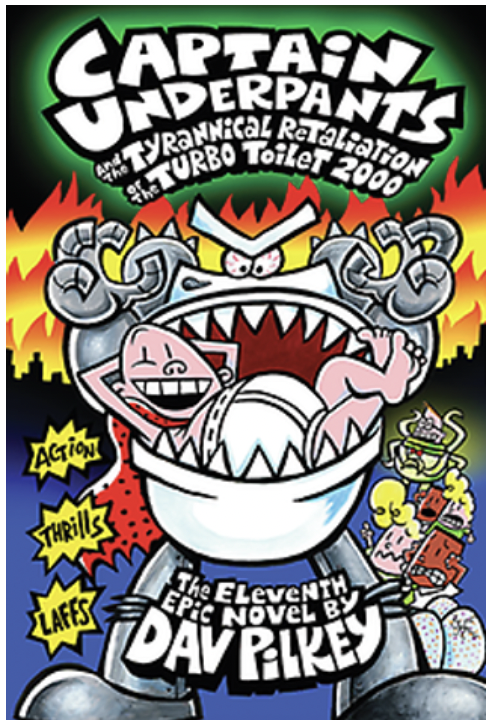Preparing Kids for the Biotech Century
Melvin’s Li’l Scientist Wristwatch had a built-in DNA extractor. Melvin inserted the filthy toenail into his watch and programmed a complete extraction procedure while the Turbo Toilet 2000 chased him back through town…
As Melvin ran screaming, his watch quickly pulverized and sonicated the toenail cells, removed their membrane lipids, proteins and RNA, and purified and isolate a single strand of Mr. Krupp’s DNA.
When Melvin reached his bedroom laboratory, he quickly fed the results into his Mecha-Computer, which identified the metallo-organic, “super-powered” substance and began replicating it in a saline gel solution. The gel percolated slowly as it oozed into a glass beaker. – Dav Pilkey, Captain Underpants and the Tyrannical Retaliation of the Turbo Toilet 2000 (2014)
Captain Underpants is not a name generally associated with biotechnology. Yet, this wildly successful (70 million copies sold worldwide) series of children’s novels may be the first exposure many children have to biotech. Probably, it won’t be their last.
Just a few years ago the idea that kids would interact with biotechnology might have been unthinkable: The costs associated with DNA sequencing and synthesis were astronomical and required expensive equipment and years of training. Practicing biotechnology in the classroom was literally out of reach.
However, with decreases in the cost of sequencing and synthesis outpacing Moore’s Law, and biotechnology and synthetic biology breakthroughs making the news nearly every day, it has become feasible to expose children to biotech practices. Indeed, it is essential they are exposed to and understand technologies that will play a fundamental role in solving many of the challenges the world faces today and tomorrow.
In contrast, kids are already being taught computer programming at younger and younger ages. In fact, seven EU countries including Britain, Bulgaria, Cyprus, Estonia, Finland, Greece and Lithuania have set up computer programming as a stand-alone subject in their primary and middle schools. Programming languages such as Scratch teach their users the same skills that professional programmers use in their jobs.
Unfortunately, until now, this type of hands-on engagement has not existed for biotechnology.
This article considers is how and why small children might be given similar opportunities, as well as the impact of doing so.
Teaching Synthetic Biology in Middle and High Schools
For the past decade, it’s become commonplace for high school students in biology and AP Biology course to use gel electrophoresis to separate DNA, RNA and proteins, and to learn how to add new genetic material to bacterial cells.
For the past decade, it’s become commonplace for high school students in biology and AP Biology course to use gel electrophoresis to separate DNA, RNA and proteins, and to learn how to add new genetic material to bacterial cells.
Nearly all teachers that teach the basics of genetic engineering use the same materials and teach the same set of experiments every year. Though these experiments introduce important laboratory techniques, they present a narrow range of experimental problems. In most cases, the laboratory experience ends when the experiment does and students are learning techniques rather than the inquiry or creativity that makes the practice of science exciting.
Earlier this year, Natalie Kuldell, Rachel Bernstein, Karen Ingram, and Kathryn M. Hart published BioBuilder, a book-length series of open-access, modular, hands-on experiments designed to be easy to incorporate into high school classrooms and laboratories.
BioBuilder was developed at MIT in collaboration with award-winning high school teachers from across the country with the goal of teaching the foundational ideas of synthetic biology, as well as key aspects of biological engineering that researchers are using in their labs today. The aim was to enrich the way that biotechnology is being taught to middle and high school children.
Among the experiments that BioBuilder teaches are how to measure variants of an enzyme-generating genetic circuit, modeling “bacterial photography,” and building living systems that produce purple or green pigment. The book and the experiments have been well received because are they easy to introduce into a typical high school biology curriculum (with little to no expense) and expose students to synthetic biology by teaching both science skills and the engineering-design process in the context of living systems.
High School and College Students Advance the Field at iGEM
Every year starting in 2004, high school, college and graduate students have competed in the International Genetically Engineered Machine (iGEM) competition. Student teams are given a kit of Lego-like biological parts from the Registry of Standard Biological Parts, work at their own schools over the summer, and design and build biological systems to solve real-world challenges. They compete in 15 tracks that now include art and design, energy labs, environment, health and medicine, and even policy and practice.
In its first year, iGEM attracted five teams of students. This year’s Giant Jamboree took over Boston’s Hynes Convention Center, attracting 260 teams of college and high school students from around the world.
In the past, teams have designed a microbe to detect and kill a fungus that has been destroying the world’s banana supply. The 2015 Grand Prize-winning team from Virgina’s College of William and Mary characterized the variability (or stochasticity) of gene expression for the most commonly used promoters in synthetic biology. Promoter regions of DNA initiate the first step of turning genomic information into proteins.
The most successful teams have even gone on to start companies based on their ideas. Among them, Ginkgo Bioworks, a Boston-based microorganism engineering company, competed in the first iGEM and recently raised nearly $50 million.
In a 2014 New Yorker article on iGEM, co-organizer Randy Rettberg commented, “We used to say we just needed to educate people about the science… We said that if they understood it, they would accept it… [but] to create an environment where [these] students can live this future, what we really need to do is involve people.”
In a survey undertaken by the Oklahoma State University Department of Agriculture, it was found that as many as 80 percent of Americans support “mandatory labels on foods containing DNA,” about the same number as support mandatory labelling of FMO foods “produced with genetic engineering.” This fundamental misunderstanding of DNA reflected a general lack of understanding of basic science.
Giving children the opportunity to learn about biotechnology sooner can only be a good thing.
#
[Thanks to Davis Endries, John Garrison, Natalie Kuldell, Taylor Hamman and Danielle Wilde for reading early drafts of this.]
If you enjoyed this post, here are some others you may enjoy.







